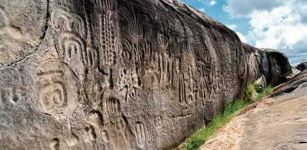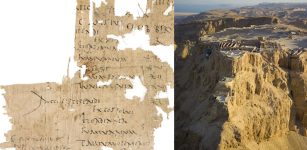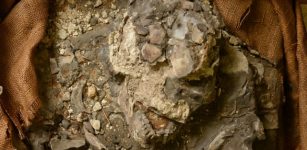Tiglath Pileser III: Neo-Assyria’s Strong King Who Built A Mighty Empire
David Tee - AncientPages.com - Tiglath Pileser’s origin is shrouded in history. Once in power, he claimed through his own inscriptions to be the son of Adad-nirari III, but that association is not proven. His father’s and mother’s name, if recorded, is now lost to time.
 Tiglath-Pileser III - King of Assyria. source
Tiglath-Pileser III - King of Assyria. source
What is known of Tiglath Pileser III is that he was a powerful governor of Kalhu or biblical Nimrud and Calah. During a civil war in 745 BC that took place after 80 years of peaceful Assyrian existence, Pulu, Tigath Pileser’s real name, assumed the name he is known by in Assyrian and biblical records.
It is not known if he started the civil war or was given charge of it by the leading citizens of Assyria of that time. What is known is that once he achieved power, he killed the royal family and took his name from previous legitimate Assyrian rulers, Tiglath Pileser and Tiglath Pileser II.
Tiglath Pileser III’s Rule
One of the first things Tiglath Pileser III did once he gained power was to take action to make sure he was not overthrown like he overthrew the Assyrian royal family. He made sure that the governors were not as strong as they once were by making it a two-many rule over each Assyrian province.
He also made sure that these government positions were filled by Eunuchs so that no political dynasties could be formed. Additionally, he divided the provinces turning 12 into 25 to make sure they were not strong enough to overthrow his reign.
In addition to these changes, Tiglath Pileser III formed an intelligent service run by trusted officials to make sure he knew what was happening in his provinces. Finally, he changed the construction of the Assyrian military and forced the provinces to send a certain amount of men to be trained by Assyrian officials.
This is said to be the first professional army in history.
Tilgath Pilesers III's Biblical Connection
He is named 9 times in the Bible and the biblical authors use both of his names. 2 Kings 15:19-20 uses his real name and states that he invaded Israel in 740 BC and forced their king, Menham, to pay tribute to him.
Tiglath-Pileser III besieging a town named U[pa?], possibly in Turkey. Image credit: Allan Gluck - CC BY 4.0
This action set up a final showdown between Israel and Tiglath Pileser III eight years later in 732 BC. At that time Kings Pekah of Israel and Rezin of Aram formed an alliance meant to wrest control from Assyria and take it over for themselves.
The two kings attacked and laid siege to Jerusalem and the Judean King Ahaz sought relief from Tiglath Pileser III. He responded and helped the Judean king by conquering their foes and killing King Rezin.
At this time, Tiglath Pileser III continued his foray, not the land of Israel conquering a variety of Israeli cities. It was his son Shalmaneser V who destroyed the northern Kingdom of Israel and deported the remaining Israelites, never to be heard from again.
Tiglath Pileser III’s Military Campaigns
Besides his foray into the northern kingdom, much of Tiglath Pileser III’s reign was consumed by different military campaigns. His first target was the Aramaean people located in Babylonia.
Once he subjected these people, he went after Assyria’s traditional enemy the Urartu in 744 or 743 BC. Tiglath Pileser III did not seem to suffer from any bad military strategies as he quickly defeated this enemy and moved on to Syria in 741 BC.
Because Syria was an ally of Urartu, Tiglath Pileser III was not kind to them. He slaughtered the people and destroyed their city. After that, he deported the inhabitants and divided Syria into an Assyrian province ruled over by Assyrian eunuchs.
Evidence Of Contact With Israel and Judah
It was Austin Layard who made the most discoveries concerning Tiglath Pileser III. Not only did he find the central palace, he also found reliefs with inscriptions and more. Many of the reliefs held images of Tiglath Pileser III, as well as his contact with both Israel and Judah.
Tiglath Pileser III died in about 727 BC of natural causes. His son Shalmaneser V, 727-722 BC, took over but he was not as strong a king as his father. Sargon II got rid of his older brother and took the throne in 722 BC and reigned till 705 BC.
Written by – David Tee AncientPages.com Staff Writer
Copyright © AncientPages.com All rights reserved. This material may not be published, broadcast, rewritten or redistributed in whole or part without the express written permission of AncientPages.com
Expand for referencesReferences:
Jones, R. (2016). Tiglath-Pileser III. In J. D. Barry, D. Bomar, D. R. Brown, R. Klippenstein, D. Mangum, C. Sinclair Wolcott, … W. Widder (Eds.), The Lexham Bible Dictionary. Bellingham, WA: Lexham Press.
Tiglath-pileser III (2001). Bible and Spade, 14(1), 23.
Two More Assyrian Kings Whose Annals Confirm Bible History (2000). Bible and Spade, 13, 38.
More From Ancient Pages
-
 Dark History Of Pömmelte, The German Stonehenge – What Can The Nebra Sky Disc And Archaeology Reveal?
Archaeology | Jul 3, 2018
Dark History Of Pömmelte, The German Stonehenge – What Can The Nebra Sky Disc And Archaeology Reveal?
Archaeology | Jul 3, 2018 -
 Countless Artifacts, Structures And Roads Discovered In Ancient City Of Aigai, Turkey
Archaeology | May 16, 2022
Countless Artifacts, Structures And Roads Discovered In Ancient City Of Aigai, Turkey
Archaeology | May 16, 2022 -
 Mystery Of The Cave Where People Vanish Or Become Disoriented
Featured Stories | Jan 2, 2024
Mystery Of The Cave Where People Vanish Or Become Disoriented
Featured Stories | Jan 2, 2024 -
 Yama – Hindu God Who Rules Over The Dead And Souls And Guards Akashic Records
Featured Stories | Sep 17, 2018
Yama – Hindu God Who Rules Over The Dead And Souls And Guards Akashic Records
Featured Stories | Sep 17, 2018 -
 Researchers Find An Elusive European Ancestor Of Lager Yeast In Ireland
Archaeology | Dec 14, 2022
Researchers Find An Elusive European Ancestor Of Lager Yeast In Ireland
Archaeology | Dec 14, 2022 -
 On This Day In History: Mathematician And Astronomer Simon Marius Independently Rediscovered Andromeda Galaxy – On Dec 15, 1612
News | Dec 15, 2016
On This Day In History: Mathematician And Astronomer Simon Marius Independently Rediscovered Andromeda Galaxy – On Dec 15, 1612
News | Dec 15, 2016 -
 Miraculous Cauldrons Of The Ancient Celtic World
Featured Stories | Apr 17, 2024
Miraculous Cauldrons Of The Ancient Celtic World
Featured Stories | Apr 17, 2024 -
 Pandavleni Caves: Skillfully Carved Rocky Realms Decorated With Sculptures And Inscriptions In Brahmi Script
Featured Stories | Aug 1, 2016
Pandavleni Caves: Skillfully Carved Rocky Realms Decorated With Sculptures And Inscriptions In Brahmi Script
Featured Stories | Aug 1, 2016 -
 The Chinese Nostradamus And His Striking Predictions
Featured Stories | Sep 15, 2018
The Chinese Nostradamus And His Striking Predictions
Featured Stories | Sep 15, 2018 -
 New Unique Ancient Underwater Finds In The Ports Of Caesarea And Acre
Archaeology | Aug 11, 2021
New Unique Ancient Underwater Finds In The Ports Of Caesarea And Acre
Archaeology | Aug 11, 2021 -
 Are The Strange Lawrence Brook Carvings In New Jersey A Cryptic Message?
Featured Stories | Feb 10, 2023
Are The Strange Lawrence Brook Carvings In New Jersey A Cryptic Message?
Featured Stories | Feb 10, 2023 -
 Unsolved Enigma Of The Inga Stone And Its Mysterious Ancient Undeciphered Signs
Artifacts | Jan 18, 2015
Unsolved Enigma Of The Inga Stone And Its Mysterious Ancient Undeciphered Signs
Artifacts | Jan 18, 2015 -
 Underground Hellenistic Necropolis With Tombs With Frescoes, Reliefs Unearthed In Naples, Italy
Archaeology | May 13, 2023
Underground Hellenistic Necropolis With Tombs With Frescoes, Reliefs Unearthed In Naples, Italy
Archaeology | May 13, 2023 -
 One Of Europe’s Most Ancient Domestic Dogs Lived In The Basque Country 17,000 Years Ago
Archaeology | Nov 29, 2022
One Of Europe’s Most Ancient Domestic Dogs Lived In The Basque Country 17,000 Years Ago
Archaeology | Nov 29, 2022 -
 Did Richard The Lionheart Order Assassins To Kill Conrad Of Montferrat, King Of Jerusalem?
Featured Stories | Dec 27, 2018
Did Richard The Lionheart Order Assassins To Kill Conrad Of Montferrat, King Of Jerusalem?
Featured Stories | Dec 27, 2018 -
 Rare Ancient Paycheck Of A Roman Legionary Soldier Found At Masada
Archaeology | Feb 16, 2023
Rare Ancient Paycheck Of A Roman Legionary Soldier Found At Masada
Archaeology | Feb 16, 2023 -
 Extraordinary 6,500-Year-Old “Noah” Skeleton Re-Discovered – A Survivor Of The Great Flood Hidden In Museum
Civilizations | Aug 6, 2014
Extraordinary 6,500-Year-Old “Noah” Skeleton Re-Discovered – A Survivor Of The Great Flood Hidden In Museum
Civilizations | Aug 6, 2014 -
 Mysterious Book That ‘Killed’ – Are Written Or Spoken Words Powerful Enough To Take Control Over Our Actions?
Featured Stories | Nov 21, 2022
Mysterious Book That ‘Killed’ – Are Written Or Spoken Words Powerful Enough To Take Control Over Our Actions?
Featured Stories | Nov 21, 2022 -
 Erik The Red: Famous Viking Outlaw Who Colonized Greenland And Was Father Of Leif Erikson
Featured Stories | Jun 16, 2020
Erik The Red: Famous Viking Outlaw Who Colonized Greenland And Was Father Of Leif Erikson
Featured Stories | Jun 16, 2020 -
 Mystery Of Lama Dashi-Dorzho Itigilov: A Mummy Whose Body Defies Time
Featured Stories | Sep 21, 2018
Mystery Of Lama Dashi-Dorzho Itigilov: A Mummy Whose Body Defies Time
Featured Stories | Sep 21, 2018

![Tiglath-Pileser III besieging a town named U[pa?], possibly in Turkey.](https://www.ancientpages.com/wp-content/uploads/2019/05/iglathPileser32.jpg)